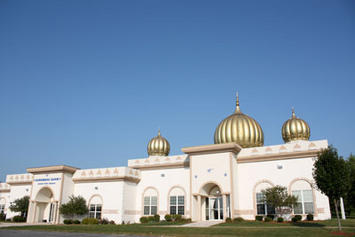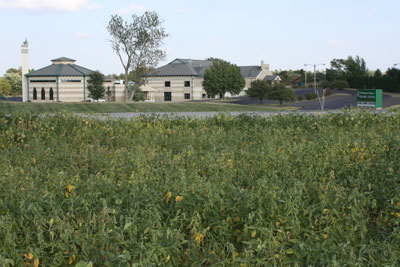
You can see the changes. A drive through suburban Lake County, IN, an hour from downtown Chicago makes you feel like you are somewhere between the set of Jean Shepherd’s A Christmas Story and the movie Hoosiers. Cultural and religious diversity would probably be the last two things on your mind in a region known more for its steel industry than its sacred space.
Yet a quick glance to the east side of Colorado Street heading south makes you question your assumptions. Neatly tucked between farm land and homes sitting on lots of an acre or more, you see two structures that cause you to scratch your head and wonder, “Am I really in Indiana?” The Northwest Indiana Islamic Center and the region’s Sikh Temple of the Sikh Religious Society of Indiana sit side by side. They provide a visual reminder that suburban America has changed.
 In fact, much has changed. Religion in America is alive and well, but it’s different. Although Christian churches continue to dominate the religious landscape in the United States, there are new religious neighbors. Cultures and religious traditions that once existed “somewhere over there”, have moved beyond the large cities of the U.S. into the suburbs and exurbs, places where evangelical mega-churches have flourished for decades.
In fact, much has changed. Religion in America is alive and well, but it’s different. Although Christian churches continue to dominate the religious landscape in the United States, there are new religious neighbors. Cultures and religious traditions that once existed “somewhere over there”, have moved beyond the large cities of the U.S. into the suburbs and exurbs, places where evangelical mega-churches have flourished for decades.
Today, the United States is arguably the most religiously diverse place on the planet. And if the ethnic makeup of the U.S. stays its course for the next half-century, religious diversity will grow exponentially. The Census Bureau predicts that minorities will become the majority in the U.S. within 40 years. Religion in America could have a more robust Latino-Catholic flavor, with Hispanics numbering one in three U.S. residents by 2050. American religious geography will also include influences from Asian Indian cultural traditions. In Bible Belt states like Georgia, Hinduism is one of the fastest growing religions with more than 40,000 Hindus in the state, according to the New Georgia Encyclopedia. By 2000, Islam had already surpassed Southern Baptists in Chicago, with more than 120,000 adherents. Less than 10 years later, Chicago’s Muslim population is estimated to be around 400,000. The big new thing is that this diversity is increasingly found in suburbs. Throughout the country’s history, the places where religious and cultural diversity have been most concentrated were her cities. In fact, this has been the case around the globe. Immigrants journeyed to urban contexts en masse. The city provided the best place for jobs, people networks, and ethnic and cultural affinities. And, a smorgasbord of religious enclaves in the city made it easy for spiritually-minded people to connect and worship with other adherents in their particular tribe.
On the other hand, the suburban and rural places were viewed as narrow-minded and ethnically homogenous. They were often seemed – and sometimes were – hostile to different religions and cultures.
In the not-too-distant past, the suburbs were, for the most part, devoid of religious adherence outside of Catholic, mainline, or evangelical groups. However, demographic shifts have put the suburbs on a different trajectory. And religious traditions have followed suit.
From an ethnic and religious standpoint, cities and suburbs have changed. Some would say they have changed sides. Of course cities will continue to grow, as more than 50 percent of the world’s population lives in city-regions today. City-regions will undoubtedly become more diverse. However, there are major changes to the way we think about communities and their populations in an area of globalization and urbanization. Demographers like Audrey Singer of the Brookings Institution have pointed out that cities have become more suburban-like, and suburbs have become more city-like, though this transition has been slowed to some degree by the current recession.
Newer cities like Atlanta and older ones like Baltimore share this same pattern. It does not matter if the city is more suburban-like, or if the city is more like the archetypical city built with an infrastructure suitable for immigrants. Both are regions where foreign-born populations bypass the city altogether. This process was well under way before the turn of the last century, when census data revealed that foreign-born populations preferred suburbs over cities.
Not surprisingly, this phenomenon also brought changes in the country’s religious landscape. Yes, the city and her urban districts remain a viable context to find places of faith, but things have shifted a bit.
For example, in the past century, Islam, by design an urban religion, certainly migrated to large cities in the U.S. – notably Detroit, Chicago, and New York. But today the ummah has spread to smaller cities and suburban settings. Many Muslims have moved beyond the urban perimeter. Dearborn, MI and Northwest Indiana’s Lake County are two good examples, but these are by no means the exceptions.
Suburban-friendly cities with large evangelical populations like Atlanta have also seen an increase in other faith traditions. In 2006 and 2007, the BAPS Shri Swaminarayan Mandir Atlanta, said to be the largest Hindu temple of its kind in the United States, was built in suburban Gwinnett County in Lilburn, GA. Much of Georgia’s Hindu population is centered in the sprawling suburbs around Atlanta. The Daily Beast recently ranked Atlanta #6 on their list of the 30 leading cities for Muslims in America (see America’s Muslim Capitals). Two other smaller cities in Georgia made the list, -- Albany and Columbus.
Not only are other religious traditions navigating the suburbs and smaller cities well, but non-Anglo evangelical populations are trending suburban too. Atlanta’s large Korean population is primarily suburban, as are the city’s Korean churches. In the ethnically diverse Atlanta suburb of Duluth, a city of roughly 26,000, the majority of new churches started since 2000 have been Korean. The Korean Church of Atlanta (UMC) is on the path to become a mega-church with new construction and an estimated 1700 people who regularly attend. Korean churches in Duluth and the surrounding area are very diverse themselves, denominationally speaking. Korean congregations include churches from Methodist, Presbyterian, Baptist, and Independent denominations.
Back in Northwest Indiana, despite the decline of manufacturing jobs and high unemployment rates, the region continues to grow, albeit incrementally. Perhaps the most intriguing statistic is the number of immigrants who have moved to the region in recent years. Between 1990 and 2000, more than 70 percent of Lake County’s growth was attributed to immigration, according to a Purdue University study on immigration in Indiana. Ethnic changes in Lake County brought shifts to the area’s religious geography, too. In the county’s suburban communities of Merrillville and Crown Point, residents can find the aforementioned Islamic Center, an Islamic school, an Indian Cultural Center, the Sikh Temple, and Serbian, Macedonian, and Croatian congregations.
Some of these changes to Lake County’s religious community came during a period of rapid decline in church attendance. In 2008, The Northwest Indiana Times reported a drop in church attendance of almost 30 percent between 1990 and 2000. This does not mean that all churches in the county are shrinking. Some, in fact, have become quite large. But their biggest source of growth may not be from less familiar religious traditions.
Economic and social values will continue to intersect new religious traditions in the suburbs as minorities and immigrant populations grow. The culture of suburbs, with individualist values, will continue to have a varying affect on how religious groups establish and sustain themselves. It will be interesting to see how new religious groups affect the culture around them in the suburban neighborhoods they now call home.
Religion is not going away as some 20th century scholars presumed. What is changing is the country’s religious complexion. How communities grapple with this change may say much about how they thrive in the future.
Since 2006, Travis Vaughn has conducted community studies in a number of U.S. cities. He is a visiting instructor at Covenant Theological Seminary and is the catalyst behind cityandcitizen.com, coming in the fall of 2010.













I like this post,And I guess
I like this post,And I guess that they having fun to read this post,they shall take a good site to make a information,thanks for sharing it to me.
Look for FHB TV Here
The Indian Cultural Center,
The Indian Cultural Center, noted in the article, recently opened a new Hindu temple on its campus.